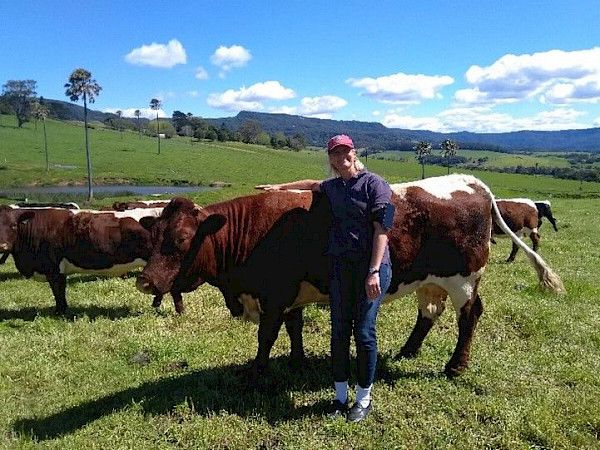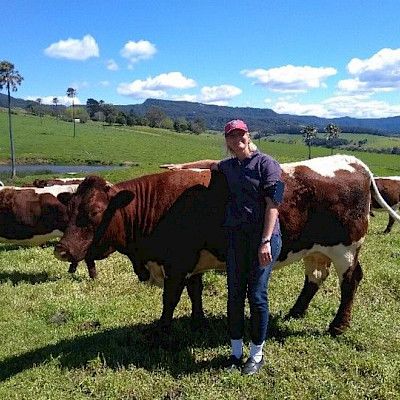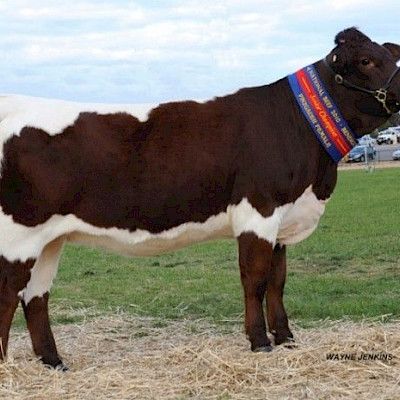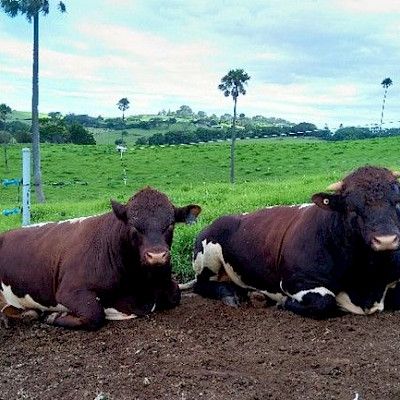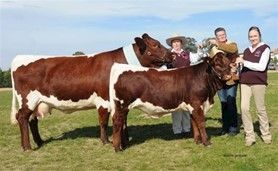About me - Julia Roso
I’m from Bregenz in Vorarlberg and have always wanted to move somewhere warmer and less foggy ever since my studies. I finally did that in 1997 - I got on a plane all by myself, flew to Sydney and never regretted it. Against all expectations, there are areas here which look just like the Bregenzerwald, except that it never gets colder than 5°C and that palm trees grow in the meadows. One example is the area where I live now, in Kiama, two hours south of Sydney. It’s really beautiful here. I have a small farm together with my husband and our two children. It’s only 42 ha - that’s very small for Australian conditions - but we can keep about 80 mother cows.
What is cattle farming like in Australia?
Australia has a very low population density, except for the coastal regions, where there are part-time and spare-time farmers near population centers. Australia also has very old and therefore rather poor soil, little rainfall and an extreme climate, so farmers have to cultivate a relatively large amount of land. In addition, Australia is committed to the free marked economy and does not see it as its job to support businesses. As a result, farms usually have to be very large to be profitable. They usually have at least a few hundred mother cows and often cultivate large fields of cereal crops at the same time. If you move farther away from the population centers into the interior of the country, there are often herds of thousands of animals on
several thousand hectares, and the ownerships relationships are privatized. Under such circumstances, it is obvious that Australian cattle never see a cowshed, nor do they see people all year round, and the infrastructure to manage such farms must be industrialized.
At the moment, there are only very few businesses that have licenses to combine their farm with a slaughterhouse. Smaller butchers are usually not allowed to slaughter here either, so all animals have to be transported to larger slaughterhouses. We hope that this situation will improve in the future and that licenses will be granted to mobile butchers who could then come directly to the farm. That would be the ideal situation for the animals, but we will probably have to wait a little longer until this concern reaches our politicians.
Why do I have Pinzgauer cattle?
Depending on the climate zone, in Australia there are either Bos Indicus herds or herds largely dominated by Angus. Black Angus cattle dominate our area. Since we only have a very small farm, we wanted something special, and we dedicated ourselves to the Pinzgauer cattle, which are considered as a rare breed here as well as at home (we have registered less than 300 active mother cows in the stud book).
They are really very special animals, which thrive even under Australian conditions. They are very sweet, resistant, and productive mother cows, ideal for smaller farms, and a wonderful reminder of Austria in our meadows.
What kinds of Pinzgauer cattle are there in Australia?
Pinzgauer cattle in Austrialia are exclusively beef cattle. They are particularly well suited for coastal areas, where there are also dairy farms, as it rains a lot, lots of fresh grass grows and mother cows with high milk production can produce calves of good quality for the slaughterhouse.
Sometimes, dairy farmers buy a Pinzgauer bull to cover their dairy cows (usually Holstein-Friesian) with and either improve the mild for cheese production or to be able to sell the calves better because they have more muscle than pure dairy breeds.
It is said that there have been Pinzgauer cattle in Australia since the beginning of the 20th century, but those were not registered in a stud book. The Pinzgauer we breed now originate from animals that came to Australia in the 90s from Canada and America either as mother cows, frozen semen or embryos. A stud book was then also founded, which is now publicly available on the internet. Until 2010, there were also a lot of breeders who exhibited their livestock, and we also have an export to Austria - Ravensbrook Caesar, which is called CESAR there. Since then, the number of Pinzgauer cattle has decreased a bit, mainly because some breeders have retired.
I was kindly asked to join the Australian Pinzgauer Breeder’s Association (www.pinzgauer.org.au), where I am now Vice-President, and so it is really nice to be a part of the international Pinzgauer Breeder’s Association. We had planned a tour for the international Pinzgauer breeders in 2020 with a visit to our farm, which unfortunately could not take place due to COVID. Hopefully, we can make up for it some day!
How do we manage our farm?
Our small farm used to be a dairy farm, but land prices near Sydney have soared over the past 20 years to such an extent that land ownership is becoming more fragmented and dairy farms are increasingly closing down. We have a subtropical grass here called Kikuyu that was imported from South Africa. It grows from November to May, and in autumn you can start sowing ryegrass and clover for the following months.
We manage the farm by letting the animals graze in a rotation, i.e. they get a new piece of meadow every day. This maintains the biodiversity of the soil and allows us to stick to biological principles. Our animals have all the best bloodlines in Australia, as we were lucky enough to get the best genetics from some of the founding members of the Australian Pinzgauer Breeder’s Association, who are slowly but surely retiring.
We use our own range of breeding bulls in the meadow. Every year, we also artificially inseminate with semen from Austria, and already have calves from kr Mars, Max and Haller Fex. If you are interested in finding out more, please visit our website www.fairfieldfarm.com.au.
Thank you for your attention
An article by Julia Roso
